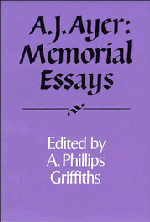Book contents
- Frontmatter
- Contents
- Preface
- A Defence of Empiricism
- Ayer: the Man, the Philosopher, the Teacher
- Ayer's Place in the History of Philosophy
- AYER'S ATTACK ON METAPHYSICS
- Ayer and World Views
- Language, Newspeak and Logic
- On the relation between Common Sense, Science and Metaphysics
- Logical Positivism and Intentionality
- Probability and the Evidence of our Senses
- Seeing Qualia and Positing the World
- Three Varieties of Knowledge
- The Importance of ‘If’
- Ayer's Ethical Theory: Emotivism or Subjectivism?
- Subjectivism and Toleration
- An Interview with A. J. Ayer
- Notes on Contributors
- References
- Index
Seeing Qualia and Positing the World
Published online by Cambridge University Press: 01 July 2010
- Frontmatter
- Contents
- Preface
- A Defence of Empiricism
- Ayer: the Man, the Philosopher, the Teacher
- Ayer's Place in the History of Philosophy
- AYER'S ATTACK ON METAPHYSICS
- Ayer and World Views
- Language, Newspeak and Logic
- On the relation between Common Sense, Science and Metaphysics
- Logical Positivism and Intentionality
- Probability and the Evidence of our Senses
- Seeing Qualia and Positing the World
- Three Varieties of Knowledge
- The Importance of ‘If’
- Ayer's Ethical Theory: Emotivism or Subjectivism?
- Subjectivism and Toleration
- An Interview with A. J. Ayer
- Notes on Contributors
- References
- Index
Summary
Qualia and Ayer's Use of Them
It is the business of philosophy to deal without presupposition with the question of the general nature of the world and with the question of how or indeed whether we can know that nature. These are questions to which answers are given in the realism of ordinary belief, as it can be called, the phenomenalism of Berkeley, the pragmatism and the scientism of Quine, and the varieties of scepticism. The ontological and the epistemological questions are bound up with another, that of the nature of perception—the question of what it is, in general, that happens when we perceive. What is called naive realism is an answer, as are representation theories, and phenomenalism again. If the question might be better defined, so as to distinguish it from the related scientific question, it is no matter of mere conceptual analysis. Let us start with this question of the nature of perception.
When Jane and Selina see the table, two things other than persons are part of the story. If Jane shuts her eyes, one of these ceases to exist. Of course, you may say, there are two of something other than persons, since there are two neural processes. However, the fact relevant to our question is different. It is that there are two things in the sense of being two perceptions or perceptual experiences, Jane's seeing the table and Selina's.
Is it still necessary to struggle against the idea that the neural processes, or parts of them, are identical with the perceptions? I shall not do that here. Nor shall I struggle with functionalism as a supposedly complete or basic account of the perceptual experiences.
- Type
- Chapter
- Information
- A. J. Ayer: Memorial Essays , pp. 129 - 152Publisher: Cambridge University PressPrint publication year: 1992

